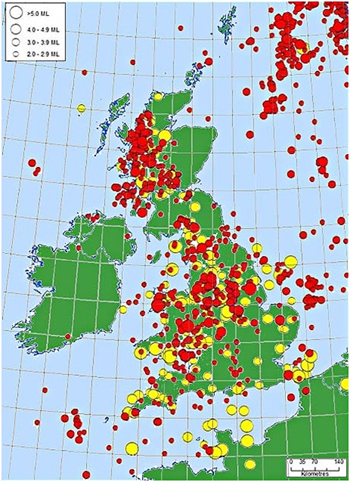Delegate Questions
Delegates sent in several questions that it was not possible to answer during the briefing meeting on 18 June 2012. These have been answered by the relevant speakers below.
- Can the gas phase in intact rock matrix (micropore gas) contribute significantly to commercial production, and how does fracking mobilise this phase, if indeed it does?
In shale gas ‘reservoirs’, micropore gas or ‘free gas’ does contribute significantly to commercial production. The amount of free gas can be estimated from downhole log data. Adsorbed gas can be estimated by desorbing core rock samples in the lab. Fracture porosity also can be an important space for gas to occupy.
In most shale gas ‘reservoirs’ most of the gas is free rather than adsorbed, though there is great variation (see for example Jenkins et al. 2008; paper SPE 103514). For example the Barnett Shale (Fort Worth Basin, Texas) has gas contents of 150-350 SCF/ton (standard cubic foot per ton) most of which is free gas. In many places, the Barnett shale contains few naturally open fractures and so nearly all wells are fracture stimulated. On fracking the adsorbed gas desorbs and travels to the well, as does the free gas. In the rather unusual biogenic Antrim shale gas play (Michigan Basin, US), gas contents are 40-100 SCF/ton again mainly adsorbed gas. The Antrim shale contains well-connected natural fractures that initially are water-saturated. This water must be removed to reduce the reservoir pressure and allow gas to desorb from the organic matter.
2. If the water used in fracking is unlikely to reach drinking aquifer sources, and only 40% is returned, it appears that 60% of water used (3 million gallons per well) is lost from the natural water cycle. How can that be sustained?
Response: The amount of water returned to the surface following injection during the fracking process as flowback water varies depending on the nature of the geological material being fractured and the complexity and scale of the operation. The water that is not returned to the surface remains in the geological formation. Although this water is no longer available for other uses on the surface the amounts involved are small compared to overall water resource availability. More locally, in the UK, management and protection of the water environment and water resources is the responsibility of the environment agencies. Their role is to ensure sustainable use of water that takes into account both human demands and environmental needs.
3. Given that seismic activity could cause surface detected earthquakes of about 2.5 and given that one bore would have at least 6 horizontal wells giving at least 6 fracs, and presumably the necessity for commercial return to have more than one bore operating, what would be the impact on the fragile chalk cliffs in East Sussex which already are subject to collapse? What is the calculated house damage in an area where no previous seismic activity has taken place and therefore no building precautions have ever been taken?
Response: The south coast is not seismicity free as historical records show:
http://en.wikipedia.org/wiki/List_of_earthquakes_in_the_British_Isles (note 1580 and Figure 1).
 Figure 1. Background seismic activity in the UK. Copyright: British Geological Survey
Figure 1. Background seismic activity in the UK. Copyright: British Geological Survey
- There was a 4.3 earthquake in Folkestone in 2007 which didn't damage the cliffs and that was c 900 times stronger than a 2.3. A 2.5 will not cause damage: http://news.bbc.co.uk/1/hi/6602677.stm
4. What measures and or regulations are envisaged to assist local authorities to protect landscapes from the potential environmental and visual damage caused by shale gas operations?
Advising on landscape impacts is beyond the remit of the Environment Agency but is the responsibility of developers and local authorities to address through the planning system in consultation with local communities. The BGS’s role, in a nutshell, is to determine the amount of shale gas and understand the subsurface environmental impact of shale gas extraction.
5. Is the current regulatory regime really sufficient to control current drilling and extraction practices to prevent surface and groundwater contamination?
The Environment Agency believes that the current regulatory regime, which was described during the presentation, is adequate to prevent surface and groundwater contamination for small scale exploratory activity but further work is being undertaken over the course of this financial year to ensure that they have all the information and resources needed and that regulation is appropriate if the industry develops to a commercial scale.